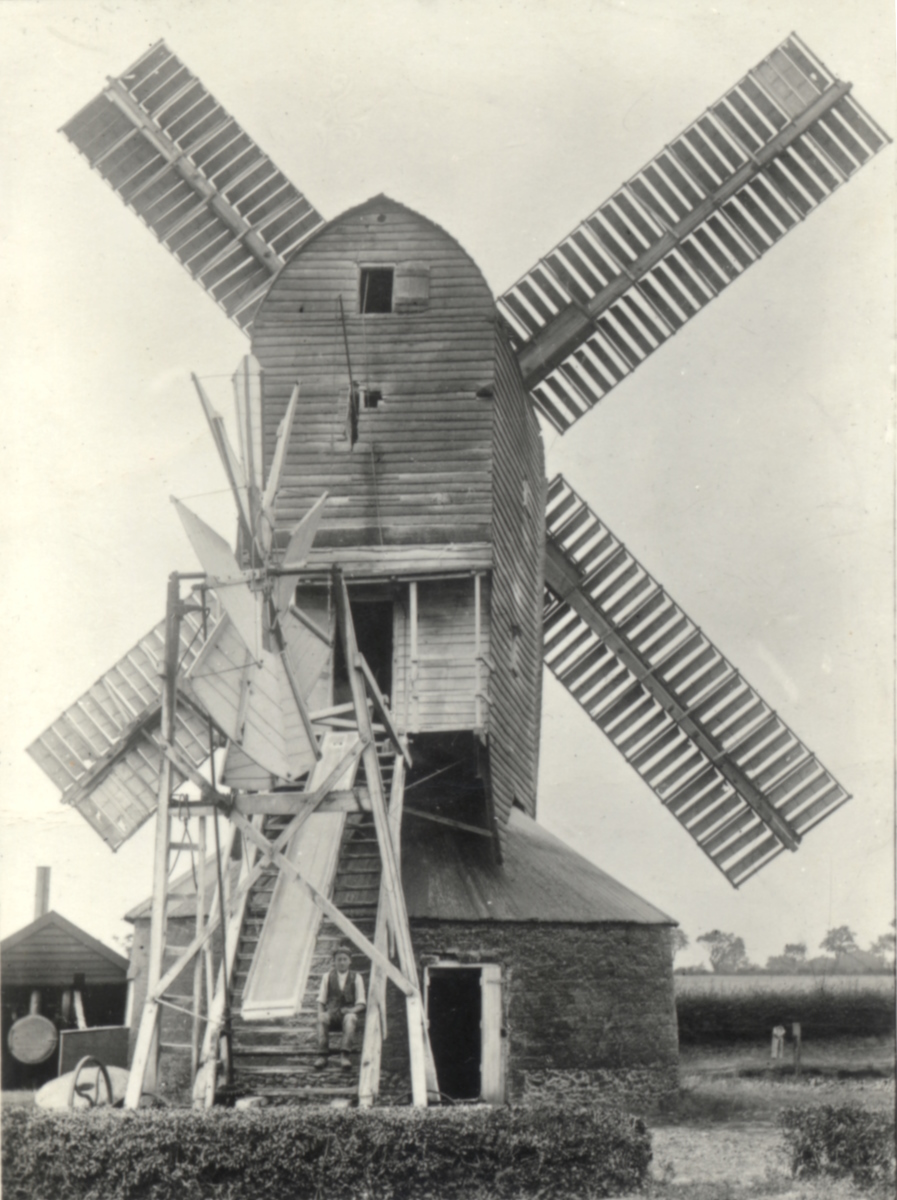
The windmill was on the site of the current Travis Perkins builders’ merchants and was established over 200 years ago. It was first shown on Faden’s Map of Norfolk, in 1797. A newspaper advertisement in 1815 describes the mill as being available to let for a 12-year period.
There was a bakery at the mill together with the miller’s house which was to one side of the site.
During the mid-1800s, ownership was passed between Henry Banham and Vincent Jermyn. Genealogical research suggests the two were related by marriage, albeit from different generations of two Wymondham families. Comparing documents, including census returns, suggests many of the actual millers were tenants.
On 3rd August in 1879 there was a great storm which caused widespread damage in the area. Wreningham’s windmill was no exception. Newspaper reports from the time state that “windmills at Wreningham and Wymondham were dismantled & much injured by the violence of the wind …”. No doubt the repairs were costly, although an 1886 auction document implies the mill had been returned to good working order.
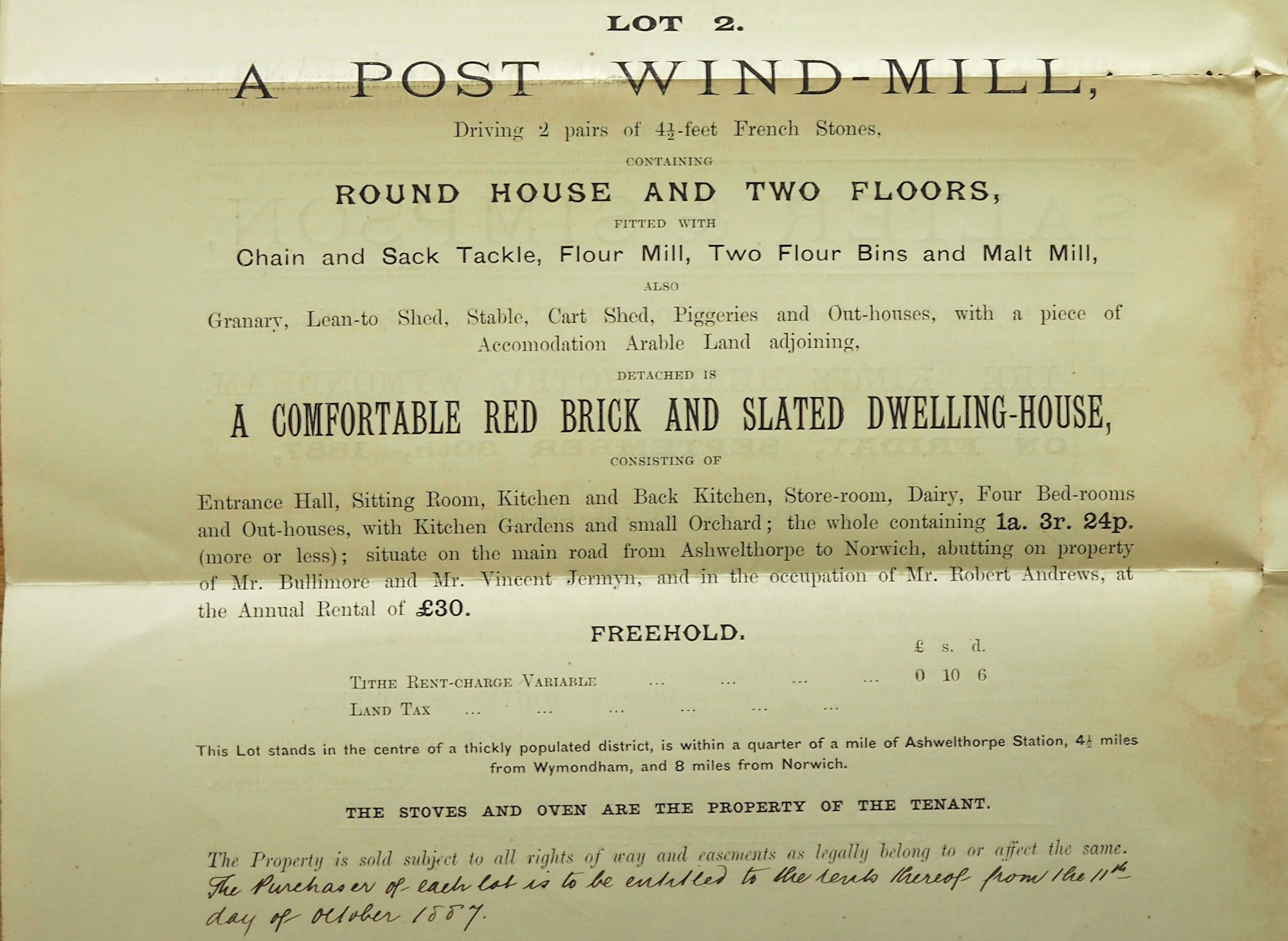
Courtesy of Wymondham Town Archive.
After this, there appears to have been joint ownership between Vincent Jermyn and John Bullimore with Robert Andrews as their tenant. In due course, Robert Andrew’s son, Harry, became the new owner, and, in 1892, a small steam engine was introduced (presumably) to provide backup power for periods when the wind wasn’t doing the job.
However, owner Harry Andrews committed suicide in 1908 – believed to be due to financial difficulties – presumably, associated with the business.
In 1910 a Mr Rackham demolished the windmill and replaced it with a totally steam powered facility; his new building still stands, today. Its fortunes changed. The steam mill, under a new owner William Bunting and later, Herbert Aldridge, is believed to have been a thriving business. Steam probably provided the predictability, reliability and improved economics which wind could not.
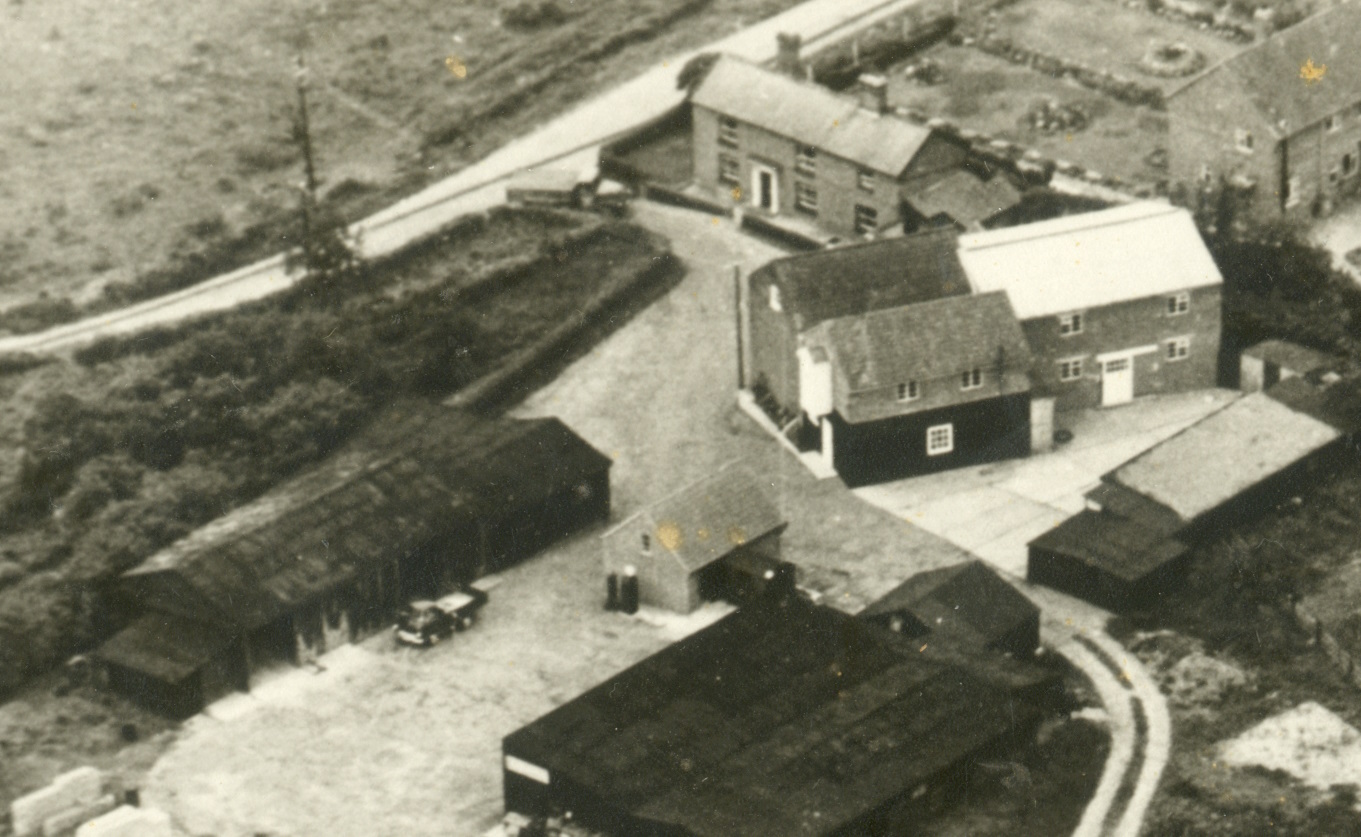
We are now speculating if the mill’s power source might eventually have been changed from steam to electricity. NB The above c1951 photograph shows no signs of a chimney, whilst the dark shape on the right side of a small brick building in the yard might well be a generator. Does anyone have any information?
A more detailed history of the Wreningham mill can be found at the Norfolk Mills website. Anyone wanting a deeper technical understanding of how windmills work might like to take a look here. It’s a lot more complicated than you might expect.
Milling came to an end in 1964/65. In due course, the steam mill was re-purposed to become a builders merchant. Information about the transition is given below.
The Aldridge Haulage Business
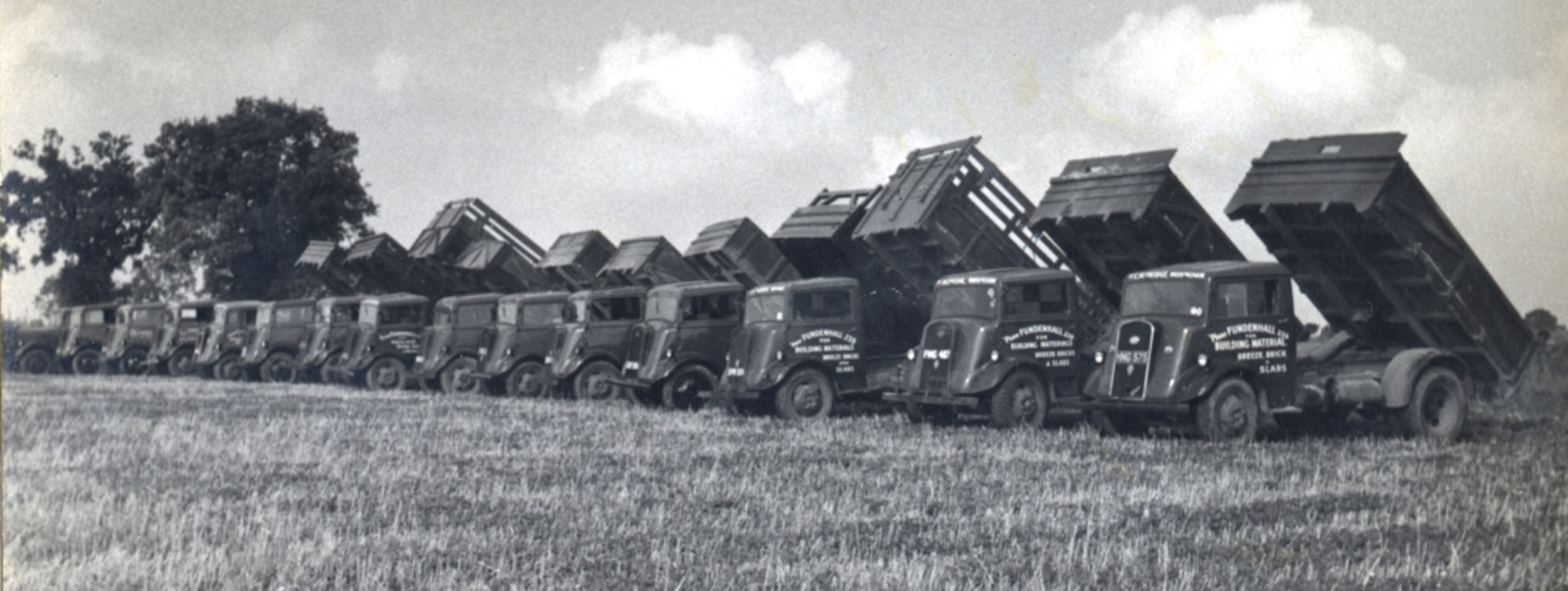
During the mid 1900s, the mill’s Aldridge family also ran a haulage business from the same location. Above and below are images of the extensive fleet of vehicles used for moving bulk materials such as stone, sand and gravel. The above photograph was taken in the field just above the mill. The date written on the rear of the following photograph is given as Easter 1946. Perhaps the above image is from about the same time.
At the beginning of World War 2, the base of the old windmill had still been in its original location; only the wooden top of the mill had been demolished about 30 years before. As a result of urgent calls for hardcore to help in the war effort, the mill’s base was now broken up and taken to Hethel where it contributed to the foundations of the new airfield. Perhaps it was the Aldridge family who transported the rubble?
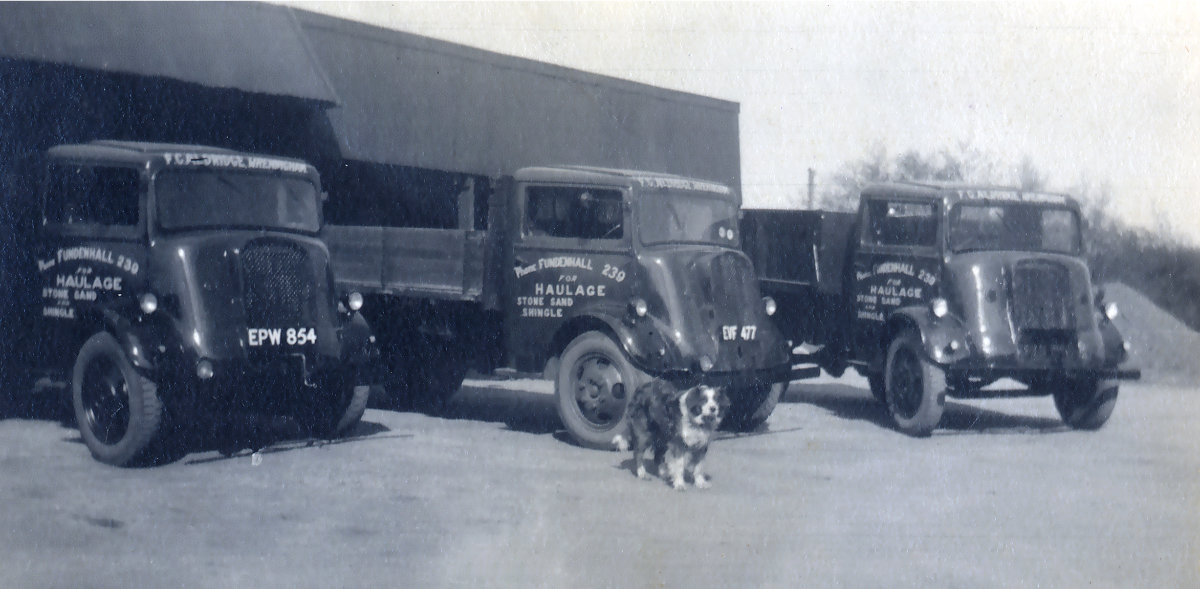
In more modern times, after Hethel airfield fell into disuse, much of the airfield’s concrete was broken up and re-used for the A11 dual carriageway construction around Wymondham. Most recently, the dual carriageway has been dug up and had its rubble recycled. Is it possible the original base of Wreningham’s windmill might now be in its third or fourth application?
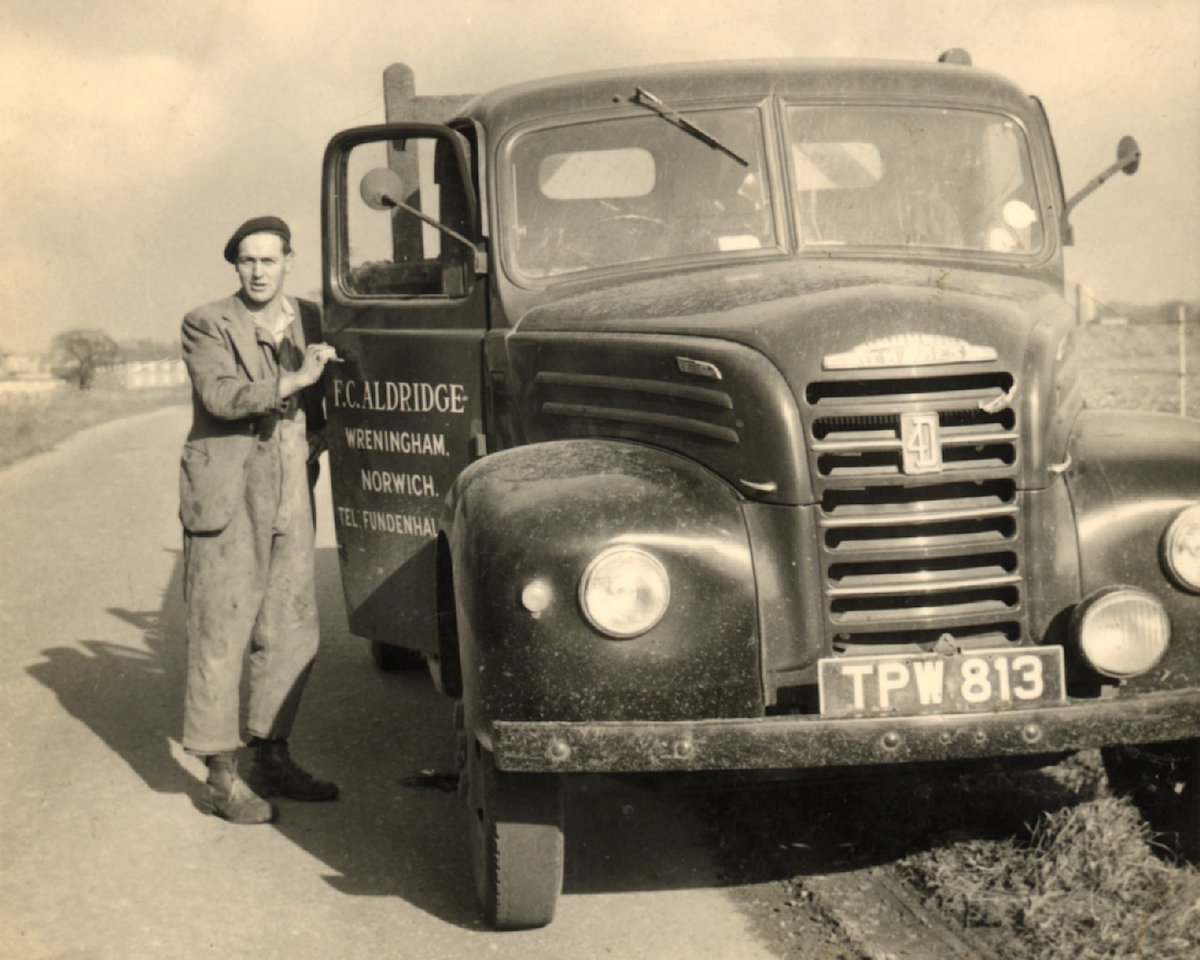
The Aldridge family eventually sold the mill site with its surviving operations to William Ashby & Son who were a builders merchants in the London area; the latter having started in that trade as a carrier of builders materials. The Croydon Archive tells us:
“William Ashby founded a business in 1825 as a barge owner and carrier of builders materials. The company later started a cement works in Greenwich in 1870 although this was abandoned in 1925 when the company became a full time builders merchants. It moved to Victoria at the beginning of the twentieth century, to London Road Norbury in 1939 and to Manor Road, South Norwood in 1972 where new premises were built adjoining the railway. During the 1960s they expanded to set up branch offices at Orpington etc ……….., They also took over two subsidiary companies in Norfolk (Aldridges and Bardwell and Sons).
William Ashby and Sons were themselves taken over by Readymix Concrete in 1979.”
We presume it would have been the Aldridge’s building materials haulage business which attracted William Ashby & Son to making their Wreningham acquisition.
A modern comment about the windmill
We would suggest that Wreningham’s windmill was not optimally located to catch “the right kind” of wind; however, 200 years ago, not many would have understood this.
The mill was well positioned from a “communications” standpoint, being located near a convenient junction with a main “highway”. However, in Norfolk, low average wind-speeds require a windmill to be on a hilltop or on a long and exposed slope (preferably facing the prevailing wind) to collect the greatest amount of wind energy. It is also important to avoid obstructions (buildings, trees etc) because those cause air turbulence – and you can’t extract useful amounts of energy from turbulent air, however “windy” it appears to be.
High Common would have been a far better location – or even further up the hill near the Bird in Hand, but still keeping clear of other buildings and trees. As things were, the potential to “find suitable wind” for long enough periods, in its Mill Lane location, must have been limited.
Mill Cottage which had been constructed directly to the south west of the mill, may have increased this problem. It was directly in the line of any south west prevailing wind – increasing the periods when the sails would have been exposed to higher levels of turbulent air; again, making it more difficult for the sails to extract useful levels of energy.
In the early 1900s, when a fully steam powered mill changed the operation to running from 100% reliable energy, all those “unreliable wind” constraints would have disappeared – and that is consistent with the outcome. The steam mill was said to have been a great success.
In the recent past, at the opposite end of Mill Lane, a small wind-turbine was erected on a mast outside Wreningham village hall to help meet the hall’s electrical requirement. Unfortunately, the limitations of the local terrain and the adjacent tall trees created turbulent air around its blades. The result was that very little electrical energy was produced. (The tall mast on which it was mounted would probably have needed to be twice the height – or more, for it to have been successful.) After this failure, the wind turbine was removed. It’s always important to understand our history to ensure we don’t repeat old mistakes.
